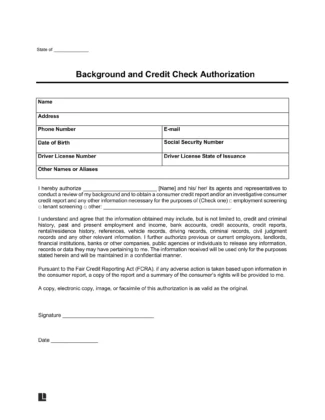
Get permission to obtain and review a potential tenant’s background and credit check with our tenant background check authorization form.

Updated June 13, 2024
Written by Josh Sainsbury | Reviewed by Susan Chai, Esq.
A tenant background check authorization form is a document landlords use to gather information before screening applicants for rental property leases. This form can provide valuable details to make your applicant search more efficient and successful.
When you provide the tenant background check form, tell the renter what checks you’ll run and how you’ll use the results. Please seek their explicit authorization to pull specific information, including credit reports, criminal records, rental history, and more. Furthermore, inform them they’ll be responsible for paying the fees associated with the background check.
A background check is an essential part of a rental application in which a prospective tenant provides information about themselves, such as their residence history, employment details, financial accounts, and personal references.
Having a tenant complete a rental application and background check authorization form can make your applicant search more efficient and successful.
Distribute a background check authorization form to the prospective tenant. Ask them to fill it out, ensuring they grant explicit legal permission for you to conduct the background check. Request their payment for the background check when they return the form to you.
In addition to granting permission, the potential tenant should also provide their personal information. They can furnish details like their full name, date of birth, current address, and Social Security number as part of the larger rental application form. With this information, you can more easily conduct your research and perform a background check.
Once you acquire the necessary information, you can run the background check. For simplicity, consider using a third-party service geared toward landlords. Please ensure whichever company you choose complies with local and federal laws.
Look into the following service providers to find the one that’s right for your situation:
Please abide by state and federal requirements when conducting background checks and using the results in your decision-making.
For example, the Fair Credit Reporting Act applies to tenant background checks. It specifically states that if you decide not to rent to the applicant based on the background check results, or you take a step like requiring a higher security deposit or increased rent because of what you find out on the background check, you must give the applicant notice (15 US Code § 1681m).
When evaluating applicants, focus on offenses that could impact the safety of other tenants or neighbors, such as violent or sexual crimes. Note that some states, like Ohio, have laws protecting landlords from liability when renting to registered sex offenders (Ohio Revised Code § 5321.051).
If you decide to rent to the tenant, draft a lease agreement containing the agreed-upon terms. If the credit report or background check results are unsatisfactory, provide the tenant with a rejection letter explaining the reasons for the denial. Ensure that the reasons you give aren’t discriminatory and comply with state requirements.
A rental background check form typically includes three key sections:
This section requests the applicant’s personal details. You can use this information to conduct the background check. Request applicant details such as the following:
Refrain from asking about an applicant’s disability, race, color, religion, national origin, age, gender, marital status, sexual orientation, or familial status. These questions violate the Fair Housing Act and many state and local laws.
Inform the applicant about the types of records you will check and how you will use their personal information. This disclosure helps ensure transparency and can prevent complaints or legal issues. The areas you may disclose include:
Obtain the applicant’s consent to conduct the background check. While some rental applications include a section for credit check authorization, it’s best practice to use a separate authorization form for clarity and legal reasons.
This section is for the person authorizing the background check to provide basic identifying information about themselves.
The person will enter their full name, address, contact information, date of birth, Social Security number, driver’s license information, and any other names or aliases used.
Write in the name of the person or entity receiving the authorization to conduct the background check.
Write in the purpose of the background check, such as a tenant or employment screening.
The person giving the authorization must sign the background and credit check authorization form and provide the date of their signature.
Download a free tenant background check authorization form below in PDF or Word format: